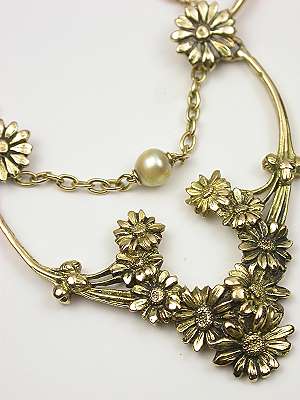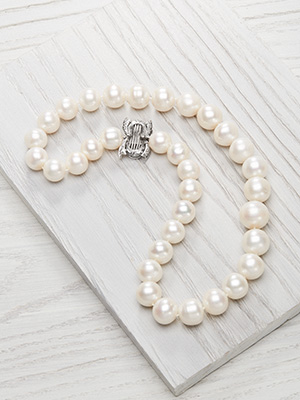Everything You Need to Know about Pearls
If you're a vintage jewelry lover, you probably own at least one strand of pearls. They've always been a classic choice, but became even more sought after thanks to Audrey Hepburn in the 1961 film Breakfast at Tiffany's.
Today, vintage pearl jewelry is a staple in any jewelry wardrobe. When you're shopping for pearls, it's smart to keep a few things in mind.
Pearl Varieties
Pearls are formed when an oyster produces nacre around an irritant, often a single grain of sand. Everything from growing conditions, to harvesting techniques, to harvest location, to type of mollusk affects the way a pearl looks.

Natural pearls are rare, and are very expensive. The Victorian necklace shown on the left has 5 natural pearls. Most jewelry on the market today is made from cultured pearls, which have been cultivated by introducing a mother-of-pearl bead or piece of tissue to an oyster, encouraging a pearl to grow.
Cultured pearls are grown in both freshwater and saltwater. Each variety is grown in a different region.

Among the saltwater pearls, Akoya pearls are grown in water around Japan and China. South Sea pearls grow near Australia, Indonesia, and the Philippines. The necklace shown on the right features South Sea pearls and a 1940s vintage diamond clasp. Tahitian pearls grow around islands in French Polynesia.
Freshwater pearls are grown mostly in man-made lakes in China.
Pearl Luster
All pearls have a beautiful surface sheen called luster. The quality of the pearl can, in part, be measured by how noticeable the luster is. If a pearl has high luster, it is very glossy in appearance, and is usually rated as excellent. If it has low luster, it appears nearly matte, and is often rated as poor.
Luster is arguably the most important indicator of quality and value of a pearl.
Pearl Colors
The main color of a pearl is called the bodycolor. They're most commonly white, cream, black, or silver. However, you'll find pearls in nearly every color of the rainbow.
Pearls also have a sort of cast of color over the bodycolor called overtone, which can be pink, green, blue, or purple.
They may also have an iridescent cast called orient, as well as variations in hue.Pearl Size and Similarity
Generally speaking, the larger the pearl, the more valuable it is. Very large pearls are rare, so they're worth more. Different pearl sizes are often used in graduated pieces, usually necklaces and bracelets.
Similarity comes into play where a uniform look is ideal. For example, it's often desirable for a pearl necklace to be made with pearls of the same size. A necklace that contains pearls of all sizes will look lumpy and mismatched. The piece may also be valued more highly when all the pearls are very close in size, color, and shape.
Pearl Necklace Varieties
If you're looking for a vintage pearl necklace, you'll want to learn some terms to help you distinguish fit and length.
- Bib: Multiple strands in increasing lengths.
- Collar: Multiple strands, 12 to 13 inches long, worn snug against the neck.
- Choker: Also multiple strands, 14 to 16 inches long, worn slightly lower than a collar.
- Princess: Classic length, 17 to 19 inches, rests at about the collarbone.
- Matinee: Drapes over clothing, 20 to 24 inches long.
- Opera: Perfect for knotting or doubling, 30 to 36 inches long.
- Rope: The longest strands, more than 36 inches long.
Pearl Grading
It's important to note that despite all the characteristics of pearls, no universal grading system exists. Unlike diamonds, the quality of pearls is subject to interpretation, much of it based on their appearance rather than any factor such as weight or origin.
Look through our extensive collection of vintage jewelry to find a variety of classic pearl pieces.





 Facebook
Facebook Pinterest
Pinterest Instagram
Instagram